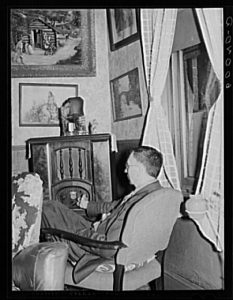Dream Project: Exhibiting Art for Your Sake
I have long been interested in the NBC radio program on art, Art for Your Sake, which aired for much of 1939 and 1940.1 Airing on Saturday evenings, promoted with aggressive marketing, and one of the first purposeful intersections of art and sound to take advantage of the radio medium, which was still young, the program was a collaboration between NBC and the National Art Society. Listeners could subscribe to Art for Your Sake for three dollars per year, and they would receive a set of sixteen color reproductions of the works of art under discussion, each corresponding to the artist who was the subject of a given broadcast. Subscribers also received illustrated brochures on the history of art since the Renaissance, but with an emphasis on twentieth-century American representational work. Each installment mixed art history with an elaborately narrated dramatization of the artist’s life, with the announcer telling the audience of subscribers when to consult their reproduction. The American artists showcased were Mary Cassatt, Emil Holzhauer, Winslow Homer, Thomas Eakins, Grant Wood, Thomas Hart Benton, Rockwell Kent, Emil Ganso, Harry Watrous, and Eugene Speicher. Kent and Benton provided their own voice, but surviving correspondence suggests that actors played the part of the artists on most programs.
Considering the tremendous success and far reach of Art for Your Sake, and its appropriation of radio in the effort to visualize cultural nationalism, I would relish the opportunity to mount an exhibition joining together the reproductions, original paintings, and importantly, recordings of the radio broadcasts. I would limit my checklist to the American works featured, since the European works—such as Leonardo’s Mona Lisa (c. 1503–5; the Louvre)—could be tough loans to secure, even for a dream project. Among the paintings and watercolors highlighted would be Homer’s Hurricane, Bahamas (1898; The Metropolitan Museum of Art), Benton’s Lassoing Horses (1930; Brooklyn Museum), and Wood’s Arbor Day (1932; private collection).2

Acquiring the loans and fabricating the listening rooms would be an arduous but feasible task. Far more challenging would be obtaining recordings of Art for Your Sake; this would require immersion in old time radio clubs and internet forums, and aggressive solicitation for leads to locate the recordings themselves. I attempted this, but was unsuccessful, when I was writing on Benton’s involvement with Art for Your Sake for a book. One radio listserv habitué chided me for thinking I could just log on and expect members to share historic broadcasts with me or give me leads where I might find or buy them.
In many instances the recorded broadcasts may well not be available—or not available in time for the exhibition. In these cases, I would hire voice actors to read the scripts (which can still be found in selected libraries’ special collections holdings), and musicians to play the soundtracks. Museum audiences have notoriously short attention spans, but it is my hope that the elaborate sound productions, replete with music and a storyline worthy of any 1930s or 1940s radio drama—playing off the paintings and reproductions before them—would hold their interest and make a case for the blurring of the sensorium in selected twentieth-century American art.
DOI: https://doi.org/10.24926/24716839.1567
About the Author(s): Leo G. Mazow is the J. Harwood and Louise B. Cochrane Curator of American Art at the Virginia Museum of Fine Arts.

